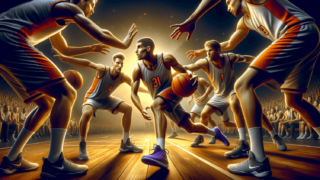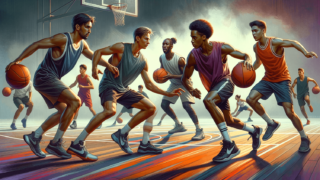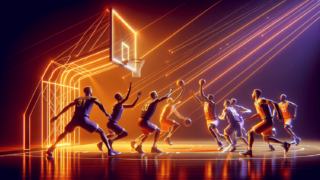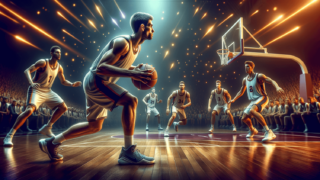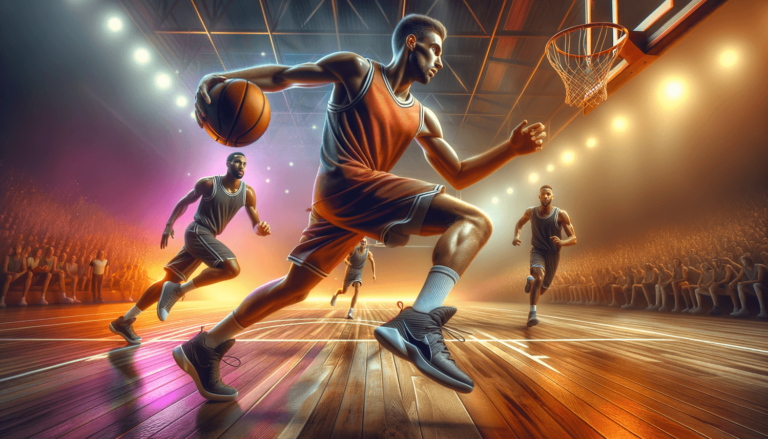
Imagine breaking the ankles of your opponents as you confidently glide through the court, leaving them in awe of your skillful ball-handling prowess. Welcome to the enthralling world of the crossover dribble in basketball! In this blog post, we will delve into the nitty-gritty of this mesmerizing move that can elevate any player’s game to new heights. So, whether you’re a seasoned pro or a basketball enthusiast eager to learn new methods of conquering the court, you’ve come to the right place. Grab your sneakers, prepare your best game face, and let’s embark on a journey to master the art of the crossover dribble!
What Is a Crossover Dribble in Basketball?
A crossover dribble is a fundamental basketball move in which a player swiftly switches the ball from one hand to the other while maintaining control and changing direction. This deceptive maneuver is used to outsmart and mislead defenders, creating an opportunity for the ball handler to drive past them or create space for passing or shooting. The effectiveness of a crossover dribble lies in the player’s ability to maintain a low dribble, quick hand movement, and agility in shifting their body weight and direction.
Unlocking the Secrets of the Crossover Dribble
Before diving into the core aspects of perfecting your crossover dribble, let’s explore the different variations of this versatile move that can enhance your game. With practice, you’ll be dribbling your way to basketball stardom!
The Basic Crossover
The basic crossover is the foundation upon which all other variations are built. In this move, a player dribbles the ball side to side in front of their body, switching hands while maintaining control. To execute a flawless basic crossover, keep your body low and your dribble quick with a swift change of direction. This deceptively simple move has the potential to leave your opponents spinning if performed correctly.
The Between-the-Legs Crossover
Want to add some flair to your crossover repertoire? The between-the-legs crossover is just the trick! Begin by dribbling the ball with your dominant hand, then step forward with your non-dominant leg, bouncing the ball beneath the leg to your other hand. By performing this move with speed and precision, you can leave defenders confounded and buy yourself extra time on the court.
The Behind-the-Back Crossover
The behind-the-back crossover is a captivating and creative variation that requires excellent ball control and spatial awareness. To execute this move, wrap your arm behind your back, bouncing the ball from one hand to the other. Doing this while maintaining forward momentum can take your ball-handling skills to new heights and frustrate even the best defenders.
Techniques for a Killer Crossover Dribble
Now that we’ve explored the various crossover moves let’s focus on the techniques that can turn your crossover dribble into an unstoppable force on the basketball court.
Mastering Ball Control
Ball control is vital when it comes to the crossover dribble. Working on your grip, finger strength, and hand placement will ensure that you maintain complete control over the ball throughout the maneuver. To improve your handling skills, practice dribbling with both hands, and incorporate various dribbling drills into your training sessions. Consistent dedication to these exercises will yield remarkable results.
The Importance of Footwork
Your footwork plays a crucial role in the effectiveness of your crossover dribble. Quick, agile steps allow for seamless movement and swift changes of direction. Incorporate foot speed and agility drills into your training, such as ladder exercises or jump rope workouts, to enhance your ability to move fluidly and decisively on the court. A player with enviable footwork can be a significant asset to their team.
Body Movement and Balance
Body movement and balance are essential elements of a successful crossover dribble, allowing for rapid changes in direction and the ability to evade defenders. Incorporate exercises that focus on the core and lower body into your fitness routine, such as lunges, squats, and planks, to improve overall stability and coordination. This foundation will significantly enhance your crossover dribble and your overall performance on the basketball court.
Demystifying the Crossover Dribble Defense
As enthralling as executing a flawless crossover dribble can be, it’s essential not to overlook the importance of defending against such a move. Understanding the defense strategies needed to combat a crossover dribble can give you a clear advantage on the court.
Stay in the Defensive Stance
When facing an opponent with exceptional crossover dribbling skills, maintaining a proper defensive stance is vital. Keep a low center of gravity, bend at the knees, and assume an open, wide-legged position. By staying responsive to changes in your opponent’s direction, you can improve your likelihood of successfully defending their crossover attempts.
Anticipate and React
Play close attention to your opponent’s movements and anticipate their next course of action. Watch their hips, shoulder movements, and body position to anticipate their direction changes. This keen sense of observation will enable you to react more quickly, allowing you to stay in front of the ball handler and prevent them from breaking free.
Active Hands and Feet
Ensure that your hands and feet are constantly active during the game, mirroring your opponent’s movements in real-time. Using your hands to swipe at the ball can disrupt their crossover attempt, while nimble footwork can keep you positioned ahead of the ball handler, making it difficult for them to slip past your defense.
Playing Smart Defense
Defending against a crossover dribble relies heavily on keeping a cool head and playing smart. Balance aggressiveness with patience and avoid overcommitting to one direction. Watch for signs that the opponent may be trying to bait you into a false move, such as a fake crossover or a hesitation step, and keep your movements calculated and controlled.
Drills to Enhance Your Crossover Dribble Game
Consistent and focused practice is the key to mastering the crossover dribble. Here are a few drills you can incorporate into your training regimen to help you take your crossover skills to the next level.
Two Ball Dribbling
Two ball dribbling is designed to improve your hand speed, coordination, and overall ball control. Begin by dribbling two basketballs—one in each hand—at the same time. As you advance, try implementing simultaneous basic crossovers and other dribble variations. This drill will undoubtedly transform your game on the court.
Cones, Chairs, or Defenders
Setting up cones or chairs at varying distances across the court serves as a visual guide for executing seamless crossover dribbles while moving. Alternatively, include teammates to act as “defenders” during this drill, adding an element of unpredictability to your practice. Make a habit of incorporating all crossover variations during these drills to keep your skills sharp.
Full-Court Crossovers
Full-court crossover drills involve dribbling the ball from one end of the court to the other while executing continuous crossovers. This high-intensity exercise can significantly improve your speed, endurance, and ball control. As you gain confidence in your crossover skills, you can increase the speed and complexity of this dynamic drill.
Learning from Basketball Icons
As you develop your crossover dribble abilities, it can be helpful to study the moves and techniques of the basketball icons who have excelled in this area. Observing players like Allen Iverson, Kyrie Irving, Stephen Curry, or Tim Hardaway can provide insight into the subtleties and nuances that can elevate your crossover dribble game. Emulating the legends can inspire you to reach new heights in your basketball journey.
The Psychological Impact of a Perfect Crossover
As you continue honing your crossover skills, it’s essential to recognize the psychological impact that a well-executed crossover can have on both the ball handler and their opponents. An excellent crossover dribble can give a player an immense confidence boost as they maneuver past defenders, gaining a psychological edge on the court. Conversely, a defender who falls victim to a crossover may experience a dip in their confidence or become increasingly frustrated, affecting their performance. Acknowledging the mental aspect of basketball and using your crossover dribble to your advantage can make a significant difference in the outcome of the game.
Preventing Injuries When Practicing the Crossover Dribble
While practicing and perfecting the crossover dribble, it’s crucial to prioritize injury prevention. Abrupt changes in direction during a crossover can put strain on a player’s knees and ankles, increasing the risk of injury. To minimize this risk, consider the following tips:
Warm-up and Stretch Properly
Always allot sufficient time for a proper warm-up before practicing or playing basketball. Cardio exercises like jogging or jumping jacks can increase blood flow to the muscles and prepare the body for the intricate movements involved in a crossover dribble. Following the warm-up, don’t forget to stretch all your major muscle groups, with special emphasis on your lower body, to ensure flexibility and reduce the risk of injury.
Wear the Right Gear
Investing in quality basketball shoes with excellent ankle support can protect your ankles against potential injuries during crossover drills. In addition, wearing knee sleeves or compression gear can also provide added stability and support to your joints, making it easier to execute sharp turns and sudden changes in direction.
Strengthen Your Lower Body
Including lower body strength exercises in your fitness routine can significantly decrease the risk of injury when performing a crossover dribble. By focusing on muscle groups such as your hamstrings, quadriceps, calves, and glutes, you can provide your joints with the strong foundation they need to withstand the impact of sudden directional changes.
The Future of the Crossover Dribble
As basketball continues to evolve, the crossover dribble has become increasingly prominent and essential for players at all levels of the game. Professionals and amateurs alike are continuously perfecting and expanding their dribble techniques, making it more difficult for defenders to predict their movements. Undoubtedly, the crossover dribble will remain a key component of basketball strategy, constantly adapting and pushing the boundaries of what is possible on the court.
Frequently Asked Questions
If you’re all set to master the art of the crossover dribble, you might still have some lingering questions on the topic. In this FAQ section, we’ve compiled 13 common questions and straightforward answers to help you better understand the nuances of the crossover dribble in basketball.
1. What makes a crossover dribble effective?
An effective crossover dribble is quick, deceptive, and versatile, allowing the ball handler to change directions easily and confuse defenders. The key to a successful crossover is maintaining a low dribble, rapid hand movement, and agility in shifting body weight and direction.
2. How do I improve my ball control for crossover dribbles?
Improving your ball control involves enhancing your grip, finger strength, and hand placement. To do this, practice dribbling with both hands, and incorporate various dribbling drills into your training sessions. With consistent practice, your ball control will significantly improve.
3. Can a crossover result in a travel violation?
No, a crossover dribble does not result in a travel violation as long as the ball handler maintains control of the ball and does not take too many steps without dribbling. Ensure proper footwork and continuous dribbling to avoid traveling.
4. Can a beginner player try a crossover dribble?
Absolutely! All players, regardless of skill level, can practice and master the crossover dribble with dedication, hard work, and patience. Begin with the basic crossover and progress to more advanced variations as your skills develop.
5. Are there any famous basketball players known for their crossover dribble?
Yes, several renowned basketball players excel at the crossover dribble, including Allen Iverson, Kyrie Irving, Stephen Curry, and Tim Hardaway. Studying their moves and techniques can provide valuable insights and inspire you to develop your crossover skills.
6. How can I defend against a crossover dribble?
To defend against a crossover dribble, maintain a proper defensive stance, anticipate and react quickly to opponent movements, and keep your hands and feet active to mirror the ball handler’s actions. Playing smart defense and avoiding overcommitment to one direction is the key to countering crossovers.
7. What is the difference between a crossover and a hesitation move?
A crossover is a dribbling technique that involves switching the ball from one hand to the other while changing direction. A hesitation move, on the other hand, aims to momentarily freeze the defender by appearing to pause the dribble before accelerating past the opponent.
8. Can practicing crossovers lead to injury?
Although practicing crossovers can put strain on knees and ankles, you can minimize the risk of injury by warming up properly, stretching major muscle groups, wearing supportive gear, and strengthening your lower body. Following these precautions can help protect your joints and maintain your overall health.
9. Is a crossover dribble only used when driving to the basket?
No, a crossover dribble can be used in various situations, including creating space for passing, shooting, or driving past a defender. A well-executed crossover dribble can be strategically employed to outsmart opponents and enhance your overall gameplay.
10. How often should I practice the crossover dribble?
Consistency is key when it comes to practicing the crossover dribble. Developing a regular practice routine that involves dribbling exercises will not only improve your skills but also build muscle memory, enabling you to perform crossovers more effectively in game situations.
11. Can a crossover draw a foul from a defender?
Yes, a crossover can draw a foul from an opponent if the defender makes illegal contact with the ball handler during the dribble. The quick and deceptive movements of a crossover can catch defenders off-guard, leading to fouls or open opportunities for the offensive player.
12. Can I combine other dribbling moves with the crossover dribble?
Absolutely! Combining the crossover dribble with other ball-handling techniques can add versatility and unpredictability to your game. Seamless transitions between different dribbling moves can leave defenders confused and create scoring opportunities for your team.
13. How long does it take to become proficient in the crossover dribble?
Becoming proficient in the crossover dribble varies from person to person and depends on factors such as talent, practice frequency, and overall dedication. With consistent practice and hard work, most players can see significant improvements in
Featured Posts
- No pillar pages found.
